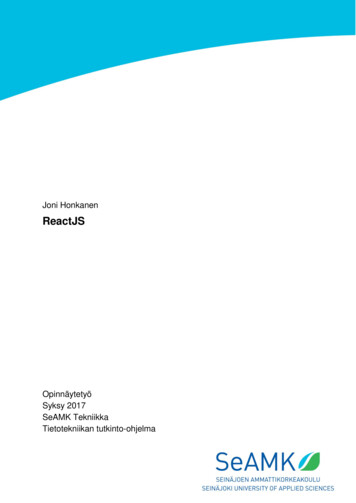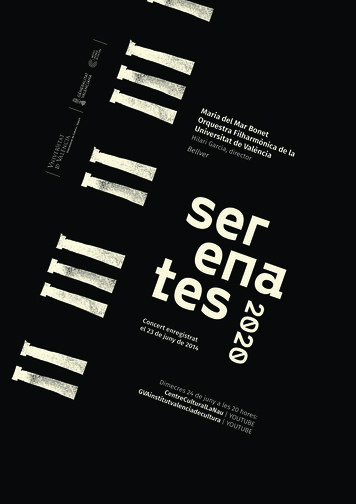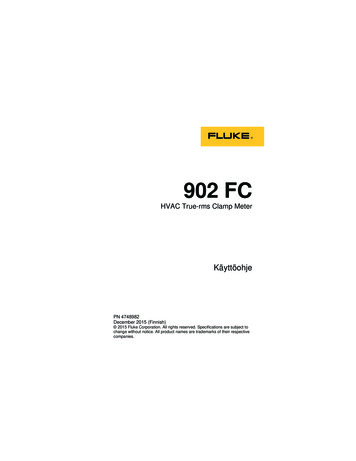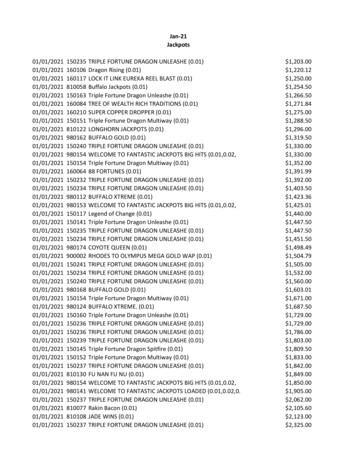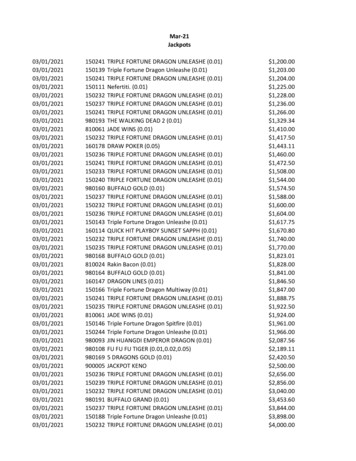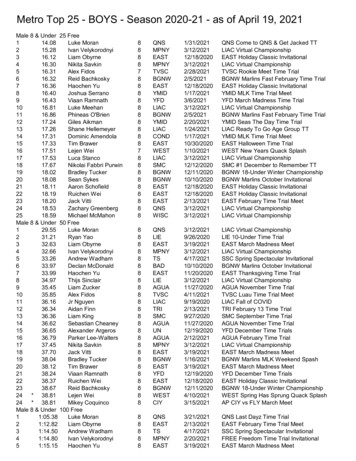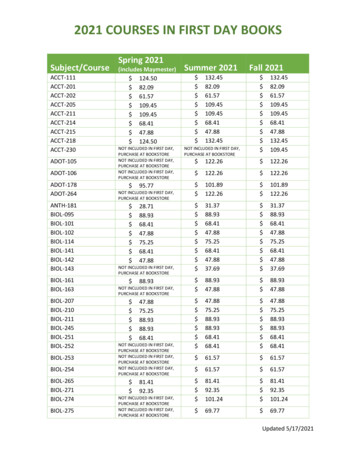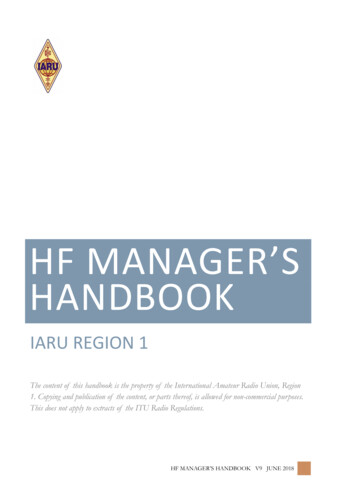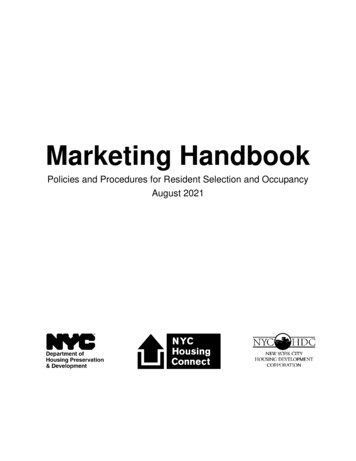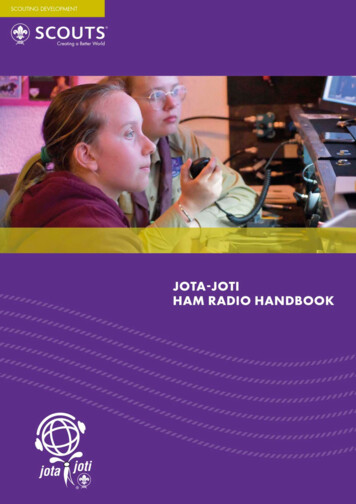
Transcription
JOTA-JOTI 2021 Handbook1
Table of ContentsWhat is “Ham Radio”? . 3What is JOTA-JOTI? . 3Amateur Radio Code of Conduct . 4Be safe . 5What is Radio, and how does it work? . 5Operator practice & code of ethics . 7Basic principles of transmitters and receivers . 8Operator Practice . 14Amateur Radio Games on JOTA-JOTI . 17Radio activity ideas: . 18Commonly used HF frequencies for Scouting events: . 19Language in Ham Radio. 20Other Links / Technical information . 21Maidenhead Locator System (formerly QRA Map) . 27JOTA-JOTI Dx Cluster . 27SDR and WEBSDR . 28QO-100 . 29DMR . 30Brandmeister . 30D-STAR. 31C4FM / fusion. 32Scheduled Radio Meetings: (ECHOLINK) . 33SSTV . 34Automated Packet Reporting System (APRS) . 35Other related links . 36APPENDIX A . 37Radio Logbook . 382JOTA-JOTI 2021 Handbook
What is “Ham Radio”?Ham Radio, sometimes also called Amateur Radio, is a technology that allows two people called ham radio operators - to communicate directly through the air.Most of the time, when people talk about “radio,” they mean broadcast radio: A station sendsout a programme like music or news, and countless people listen to that same station using areceiver, it is often also just called “radio.”In ham radio, everybody can be the sender and the receiver - just like a phone call, the twosides take turns talking. While many other technologies allow this, for example, the internet orthe public phone network, ham radio is unique. It does not require any network or centralfunction to operate - the two stations exchange signals directly through the air.There is a wide range of ham radio devices. For example, from toy radios for kids, which inmost countries can be used by anyone, all the way to large stations with special licences thatcan send their signals halfway around the world and even up to the International Space Station.“Ham Radio” and the people that use it is an extraordinary world, full of technology and specialwords that need to be learned. But all newcomers are very welcome, and all experienced hamradio operators love nothing more than introducing someone new to this exciting world. JOTAJOTI is the perfect event to explore Ham Radio!What is JOTA-JOTI?A Jamboree is a large gathering of Scouts, either global or national, and traces its roots back tothe early days of Scouting in the last century. The first World Scout Jamboree was held in 1920,and it still takes place every four years.As ham radio became popular among Scouts, the idea of holding a Jamboree remotely, usingham radio: the “Jamboree on the Air” was born and first held in 1957. Later, when the internetbecame increasingly popular, the “Jamboree on the Internet” was created in 1995. Today, thetwo events have merged into a single experience called JOTA-JOTI.JOTA-JOTI always takes place on the third weekend of October, with over 2 million Scoutsparticipating.In this manual, we teach and guide you as a Scout or Scout leader about participating in JOTAJOTI using amateur radio technology: How it works, Radio operator practice, technicalbackground, activities and ideas, rules and regulations, specific radio language, handy tools,and links.Important: Radio regulations differ from country to country. This manual is not areplacement for local rules. We recommend that all Scouts work with a local radioamateur who has all the required licences.JOTA-JOTI 2021 Handbook3
The activity of radio amateurs is like driving a car; it must obey a code whose objective is toallow people to travel on the airwaves without hindrance because everyone knows the rules andfollows them.After passing an exam, one is granted the right to use an amateur radio station and talk overthe air, possibly over long distances.However, you will be able to speak on the microphone yourself under the conditions describedbelow: the station is under the effective control and in the presence of a licensed amateur radiooperator; you can say your first name and a few words using the international alphabet you know how to use the CQ calling procedures and the Q (amateur radio) and J (Jamboree)code you have prepared one or two sentences or a question to ask your listener. You can use thisexample: fJOTA-JOTI is not a competition. There are no points or time limits for contacts.JOTA-JOTI is a fantastic event during the 3rd weekend of October. We are making and exploringold and new friendships on a weekend of experiences, connections, and communications withScouts worldwide.Amateur Radio Code of ConductThe basic principles that should govern our code of conduct on the ham bands are: FRIENDLY, BROTHERLY SPIRITTOLERANCEPOLITENESSUNDERSTANDINGThe Radio Amateur is: ICFor more please read: ct and/or Ethics andoperation procedures for the Radio Amateurs (Edition 3, 2010)4JOTA-JOTI 2021 Handbook
Be safeWith all of its opportunities and enriching content, using the Internet and Amateur Radio alsocomes with many risks, including threats to personal data, wellbeing or safety.We strongly encourage all participants to take our Be Safe Online e-learning course to learnmore about online safety and to be fully prepared for JOTA-JOTI and other online activities.https://www.scout.org/elearning beingsafeonlineMore information can be found athttps://www.jotajoti.info/be-safeWhat is Radio, and how does it work?Radio is the technology of signalling and communicating using radio waves. A radio wave ismade by a transmitter and will be received by a receiver. A radio transmitter is an electronicdevice that converts communication like spoken words via an antenna into electromagneticsignals. In between the Transmitter and the Receiver, there could be distortion that could affectunderstanding in communication. All kinds of different types of transmission on variousfrequencies are possible. You will be familiar with broadcast radio, eg, to listen to your favouritemusic in the car. The critical point is that the transmitter and the receiver have to be on thesame frequency. For decoding the message, they should be in the same mode to understandthe communication (for example, two different countries using one language to understand eachother). They could make an appointment about how and when they planned to have aconversation by following the International regulations for Amateur Radio.In general, the higher the transmission frequency ( 50MHz), the shorter the possible receivingdistance. The lower the frequency ( 50MHz,) the more efficiently the transmission could travelworldwide. It is just like audio signals. If there is a music festival with a rock band in a park, thelow frequency (bass) sound could be heard at a much greater distance than the higher tones.Most common frequencies as used in radio waves by Ham Radio.There are 2 groups: High Frequency (HF 50Mhz) or Very High Frequency, Ultra HighFrequency (VHF-UHF 50Mhz). Radio waves could be compared to (visual) light. Light is also a ’frequency’ but it is much higher in frequency and visible to the human eye. An antenna can bedirected, like a light source (light bulb or torch). So depending on the type of antenna, radiosignals can be directed in all directions or sent as a beam in one direction, just like light.JOTA-JOTI 2021 Handbook5
UHF VHF Radio SignalsRadio transmitterFor higher frequencies from 30MHz to 300MHz (Very High-Frequency VHF), 300MHz-3GHz(UHF,Ultra High Frequency), an object could hinder clear reception of a signal. The object could“reflect” the radio signal, just like a light source. If you are using a lamp and something isstanding in the middle of the beam, this will result in a “Shadow.” There will be less or no lightbehind the object.High-rise buildings, cities, or even the curvature of mother earth could be ’an issue’ for UHF andVHF. Satellites, repeaters or high antenna towers can solve this issue by receiving and repeatingthe signal.HF Radio signalsFor lower frequencies in the HF spectrum ( 30MHz), the magnetic protection shield around theearth can help reflect signals and make it possible to use these layers for really long distances.The way this protection shield helps or disrupts a radio signal is a combination of the earth’smagnetic field and the magnetic transmission of the sun, just like the weather forecast. Everyday or hour, conditions can differ.To understand what is happening, if the sun produces a ’solar flare’ (magnetic), the earth reactsin these layers to protect itself. We can see this solar activity, it is known as the Northern Lights(or aurora borealis). So the earth has a layer around the planet to protect us from incomingmagnetic fields.You can see the solar forecast on youtube z8f4PKgKsag6JOTA-JOTI 2021 Handbook
When HF radio signals are transmitted, the transmission goes from earth to these F-Layers. Thesystem works in reverse. The protection (F) layer around the planet reflects the signals frominside and tries to keep the signal inside these layers. So the earth is helping the HF signaltravel around the world. If there is an “opening” in the F-layer reflecting the signal back to landsomewhere around the world, it would be possible to receive this signal many kilometres m of how HF signals can travel around the world.In JOTA-JOTI, a radio can be used to connect. In this guide, we are trying to provide some basicskills and conventions that are helpful for radio communication (during JOTA-JOTI). If you arespeaking a different language, understanding could be an issue. So with amateur radiocommunication, we have a global tool to talk to each other.Operator practice & code of ethicsDuring JOTA-JOTI, we are talking to other stations. As mentioned earlier, to use a radiotransmitter, you need to have a licence or licensed amateur next to you to make the radiotransmission. You cannot play music with an amateur radio licence (that requires a differentlicence). During the conversation, you can talk about the weather, techniques, school, yourScouting games, or talk about the JOTA-JOTI event. You cannot talk about religion or makeJOTA-JOTI 2021 Handbook7
political statements. It is an excellent way to make friends every day around the world, sharingknowledge and the love of technology to connect with one another other!Basic principles of transmitters and receivers(On / Off, Volume, Frequency, Mode, Squelch, PTT)There are radios for mobile or stationary use. There are all kinds of transceivers, and just like acar, there are many different models ranging from minivans to sports cars. They are all ’cars,’and all require the same driver’s licence, but they all work a bit differently or have differentbuttons at different places and have specific functions for applications. But overall, they all havea steering wheel, wheels, tyres, engines, and headlights to bring you to the finish line.The same is the case with amateur radios. There are many different types and brands. In thispart, we want to show some basics of transceivers that can be used. The main differencebetween a transceiver and a receiver is that the transceiver can transmit (send out yourmessage via the antenna) and receive signals. A receiver can only receive radio signals (as thename says).Overview of a RadioTo turn the radio on (or off), find the ’on-off’ button. Be sure before powering ’on’, the powersupply should be connected, and the correct antenna for a specific band connected to the radio.This power ON/OFF could be a power button or a knob (volume).With the radio ON, before we make a connection or listen to radio signals, we need to talk aboutsome of the functions of these devices.On the radio’s display, there could be a lot of information. Some of the essential elements are:8JOTA-JOTI 2021 Handbook
To ’Tune in’ a frequency, you must select the same frequency as the receiving station or choosean empty frequency to start a conversation. This is usually done with the large main dial (largerotary knob).Now you need to choose your operating mode. {MODE SELECT} This is like language. If you aretalking in English and the other station is talking Russian, you can hear but not understand eachother. Mode is a sort of language to transmit how the signal is being modified by the transceiverto the antenna. The transceiver is just like a big translation machine. FM Mode (Frequency Modulation)AM Mode (Amplitude Modulation)JOTA-JOTI 2021 Handbook9
SSB (USB - LSB) (Upper or Lower Sideband of an AM signal)CW (Morse code)Data modes (Packet or digital modes with a computer)There are certain main (most used) Modes for specific frequencies. They are listed for eachregion and frequency. Worldwide this can be found in the Ham Radio ’band plan’ of (togetherwith the maximum power allowed for transmission).You can select a band (eg 20m - 14.190 MHz) and the { USB MODE } turn on the volume andlisten to the signals. (If nothing else, you will hear noise, maybe. There is no one there, tune into another frequency).If you have selected a frequency and mode (matching with your antenna), you will be able tocontact the other station by pushing the {PTT} button on your microphone (Push To Talk).Do not be afraid of the microphone. It is ok to speak directly into it.You have to talk close to the microphone (10cm away, but you can still see the micro in yourhand); first PUSH the button; then TALK; otherwise the other station will not be able to hearyou because the transmitter in the radio {TX} will not have been activated yet). After you arefinished talking, you must release the button to listen to the other station.In some modes {FM} the noise can be turned off with the SQUELCH.If a station is talking into the microphone, and our reception signal is sufficient, the squelch willautomatically open the audio on the level.10JOTA-JOTI 2021 Handbook
An example of the USA region Band Plan for Ham Radio frequenciesFinally - To provide the other radio station a receiving report, on the radio you will find a ’VUmeter’ or ’level meter’ in the display to give the received signal strength in ’RST’. (More aboutthese reporting numbers is shown on the next page of this manual)JOTA-JOTI 2021 Handbook11
Because every station has a different radio and antenna and a unique distance, every signal isdifferent. Radio operators are interested in how strongly the signals are being received.Transmitting and receiving a signal separately from each other is called a Simplex connection.A connection like a telephone (listening and talking at the same time) is called Duplex.With many radios nowadays you can use a wide variety of ’Filters’ to make the reception ortransmitting signal much easier to understand. Common filters are {CWfilter} -Bandwidth filter,{DNR} -digital noise filter and {Notch filter} -to clear unwanted audio signals like interferingtones or heavy background noise signals.Signal Report RSTThis information is used to indicate to correspondents the quality of the signals received. Intheir jargon, radio amateurs call it a ‘Report’.(RS for phone/ spoken words, RST for {Mode} cw)For example, FIVE and NINE indicates : (R) Perfectly readable, (S) Extremely strong signalsReadabilityR1R2R3R4R512Unreadable.Barely readable, occasional words distinguishable.Readable with considerable difficulty.Readable with practically no difficulty.Perfectly readable.JOTA-JOTI 2021 Handbook
Signal strengthS1S2S3S4S5S6S7S8S9Faint, signals barely readableVery weak signalsWeak signalsFair signalsFairly good signalsGood signalsModerately strong signalsStrong signalsExtremely strong signalsToneT: for dial tone, is only used for Morse code and digital communications. Values go from 1 (veryirregular) to 9 (crystal clear) and provide information on the quality of the sound heard.TlT2T3T4T5T6T7T8T9Extremely rough hissing noteVery rough ac note, not musicalRough, low-pitched ac note, mod. musicRather rough ac note, mod. musicalMusically modulated noteModulated note, slight trace of whistleNear dc note, smooth rippleGood dc note, just a trace of ripplePurest dc noteNow you have some basic knowledge of the techniques behind radio equipment foroperating during JOTA-JOTI! Next, we will look at what we could tell the other stationand how we talk to each other over our radio connection.Of course, during JOTA-JOTI, a Scout leader or the Ham radio operator could help you make theconnection to another radio station happen. Making connections with the magic of amateurradio is pretty cool!JOTA-JOTI 2021 Handbook13
Operator PracticeHow to ’set up’ a radio connection?For a radio connection, we need the following An amateur radio transmitter an antenna a licence and or licensed ham radio operator to help you out.Every radio station has its own ’call sign’. This is just like the number plate of a car. The firstletters (called the prefix) show the country or the region, followed by a number. The followingletters are random or could be chosen by the radio amateur station.For example, let’s look at call sign LX9S: LX stands for Luxembourg, 9 is locally regulated as aclub station, and S has been chosen for Scout. So in this example, LX9S is the European stationduring JOTA-JOTI. , The radio operator needs to announce the station’s name (call sign) at leastevery 5 minutes if it is active (ON AIR).To spell your call sign name or town (QTH), the NATO phonetic alphabet is used internationally;14JOTA-JOTI 2021 Handbook
Setting up a connection by radio: What to say.One of the rules is always to state your caller’s code and then the code of the station you areusing (you from me) at the start and end of your programme.This is a general call for JOTA-JOTI for the Scout example station LX9S in Luxembourg, EU.Once an amateur station reacts- What to say during a conversation (QSO)? - you can have anormal conversation ;)The station is returning the microphone - JOTA-JOTI 2021 Handbook15
After his reaction; this station has returned the microphone to you:The microphone is going back from you again to the other station. Now, you can register the conversation in the logbook and write a “QSL” card to the station toconfirm the connection you just made. And you can start all over to request any call.You will find a blank sheet and logbook, in Appendix A at the back of this guide.Sending QSL cards for confirmationAfter a connection with an amateur station has been made, you can send a confirmation carddirectly (by mail) to the QSL Bureau. All cards sent to the bureau are sorted by country anddistrict handed over to the central organization. These cards will be handed over from person toperson to save the bureau postage!Example: QSL cards sent for Scouting-related activities and a sample QSL Card16JOTA-JOTI 2021 Handbook
The QSL card is to confirm that you have ’worked’ the other station. A lot of radio amateurscollect these paper QSL Cards. Some of these cards are unique and designed only for an eventor a special call sign. It is just like a postcard from summer camp to confirm you are there,having fun. The QSL cards are also available digitally with E-QSL or LOTW. This is a muchquicker way to send your card Confirmation.The (paper or electronic) QSL Card should contain the information collected and shared. Suchas:- Receiver infoCall sign you are sending to- DateDate of the QSO- TimeTime of the QSO- Frequencyfor example 14.190Mhz or 20M- Signal Report (RST)599- ModeMode of transmission (such as FM, AM, SSB)- Your (operator)namePersonal name(s)- Note; If there is some space left on the card you can write a short comment or personalmessage such as “Thank you it was my first QSO ever!”.Amateur Radio Games on JOTA-JOTIFoxHunt or RDFFox hunts are an excellent JOTA-JOTI activity though not part of the main radio activity; theyare a good way of keeping younger members occupied while not on the radio. Common Foxesused are FM bugs from jaycar, or the like, but bigger and better foxes have been used in thepast. Scouts could even build receivers or the fox as part of another activity.Fox hunting is a game where a transmission signal has been hidden. The game is to search andspot the transmitter. This could be done as a ’walking’ foxhunt in, for example, a park or forestduring JOTA -JOTI or could be done with a larger transmission signal (a static hiddentransceiver or a moving (high altitude) weather balloon) over a wider area where you need acar to reach the foxhunt hiding or landing spot.If you do not have a foxhunting radio, you can program some MicroBit electronic devices. Therange is lower ( 30m), but it’s cheap.In stock/category/136radioScoutisme?download 3255:microbit-beacon-radioScoutingIn tock/category/136radioScoutisme?download 3125:microbit-recherche-ta-baliseJOTA-JOTI 2021 Handbook17
Radio activity ideas:The JOTA-JOTI platform offers a variety of ideas that can be used for complementary activitiesto make the JOTA-JOTI local event more varied and exciting and help Scout/Guide leaders teachradio techniques and good communications practice.All the activities can be performed respecting common COVID safety rules. These ideas are forboth experienced radio operators and Scouts, Guides, and leaders who would like to learn moreabout radio communications. Most activities do not require a ham radio licence. The list ofavailable activities is shown below; you will find their description at the JOTA-JOTI amateurradio hub.Links to all these activities can be found at https://www.jotajoti.info/jotaBasic activities How to build a Morse keyHow to use a radio (CB - PMR)How to manage a radio communicationHow to use ZelloGame: prisonersGame: battleshipGame: maps and pathsGame: red mooseIntermediate activities How to build a dipole antenna for Citizens Band (CB)Game: radio listening - stations from all over the worldGame: spy story!Game: monument huntGame: triangulationGame: number stationsGame: subtone telephone gameAdvanced activities How to build a crystal radioHow to build a Morse transceiverSSTV images from spaceCall (QSO) the International Space Station via Amateur RadioGame: radio listening - digital modesGame: radio listening - naval messagesGame: fox huntingNo young people at the station?:If you do not have young people at your station, you can still answer JOTA-JOTI stations butadvise the operator that you currently do not have any youth members, but you are happy totalk to their youth members.18JOTA-JOTI 2021 Handbook
Commonly used HF frequencies for Scouting events:BandsSSB (phone)CW (morse)80 m3.690 & 3.9403.570 MHz40 m7.090 & 7.190 MHz7.030 MHz20 m14.290 MHz14.060 MHz17 m18.140 MHz18.080 MHz15 m21.360 MHz21.140 MHz12 m24.960 MHz24.910 MHz10 m28.390 MHz28.180 MHz6m50.160 MHz50.160 MHzJOTA-JOTI 2021 Handbook19
Language in Ham RadioHere is a short list to help you understand what Ham radio amateurs are saying:AbbreviationsCQ: general call (addressed to all stations)CW: Carrier wave used for Morse codeDX: distant contact (different continents)R or Rgr: Roger - OkRST: Readable Signal Tone - To identify in numbers the quality of the signal as receivedRX: ReceiveSDR: Software Defined Radio - A receiver for (radio) signals in a Personal ComputerTNX or TKS: Thanks - this ham radio abbreviation is widely used for Morse / CW transmissionsTX: TransmitUTC: Universal Time Coordinated is the primary time standardWordsBuro: QSL by Buro - a well-established system for sending amateur radio QSL cards in bulkfrom amateur to amateur. It does take more time than mail, but the QSL bureau provides amuch more cost-effective way of sending cards.Call (or call sign): Registration number of a ham radio amateur or amateur organizationContest: an event in which people compete for supremacy in ham radio.JOTA-JOTI: Jamboree on the Air -, Jamboree on the Internet - World largest Scouting eventevery 3rd weekend of October.Pile-up: accumulation of calls to a single stationQSL card: A postcard-sized card used to confirm contact or a report of a station that has beenheard. These cards are often exchanged between radio hams or CB enthusiasts. They are alsofrequently sent out by short-wave broadcast stations to confirm a reception report.S Meter: A Signal meter on a receiver or transceiver indicates the signal strength of incomingsignals. It is normally marked in "S" units from 1 to 9.Shack: A radio room originally a ship's radio room, but now often used to describe a radioham's stationSquelch: A control on a receiver or transceiver used to mute or turn off the audio when nosignal is present. This prevents large noise levels from being present on the output when thereis nothing to be heard.Vertical: A vertical antennaVSWR (or SWR): Voltage standing wave ratio. A measure of the power returned from theantenna when the antenna and feeder are not correctly matched.Yagi: A type of beam antenna. (Most television antennas are Yagis).YOTA: Youngsters on the Air - an organization (non-Scouting) of ham radio amateursencouraging young people to enjoy making radio contacts.Numbers59: Given a lot as a standard answer for signal reporting “RST” (and still asking what is yourcall sign) )73: "I send you my best regards."88: "I kiss you" OR KISSESLINK: https://www.electronicsnotes.com/articles/ham radio/abbreviations codes/abbreviations.php20JOTA-JOTI 2021 Handbook
Other Links / Technical informationJOTA Originals WebsiteA lot of historical information about the history of JOTA dating back to 1957 can be found onhttps://www.jota-originals.ml/“Feel free to download them and mention this web page in your JOTA-JOTI communications toothers.”JOTA-JOTI 2021 Handbook21
NATO Alphabethttps://en.wikipedia.org/wiki/NATO phonetic alphabet#/media/File:FAA Phonetic and MorseChart2.svg22JOTA-JOTI 2021 Handbook
Morse Codehttps://en.wikipedia.org/wiki/Morse codeJOTA-JOTI 2021 Handbook23
Morse Specials CodesAbbreviationMnemoniccodeSOS.--. InternationalEmergency-.- Contact, request tosendHH. issue in decoding onthereceiver side(8points) BT-.- Separation (stop),new paragraph AR.-.-. In message/transmission (“overtoyou.”)I’m waiting for aresponse from you?IMI.--. Not understood,Please repeat!VA, SK.-.- End of contact, I amnot expectingan answer from youK (k)24JOTA-JOTI 2021 Handbookcomment
J CodeScouting has its own “short code” language. We are a worldwide organization with aconsiderable variety of languages. To talk to each other or give some basic information aboutyourself, you can use the J code.https://www.Scout.org/node/10137JOTA-JOTI 2021 Handbook25
Q codeMost commonly used Q Codes in Ham RadioLink to the complete list of Q codes: ing your location - The QTH locatorTo address the location of the radio installation, we use a ’locator grid’. This is a series of lettersand numbers around the globe like the grid on a map to provide your location or area.26JOTA-JOTI 2021 Handbook
Maidenhead Locator System (formerly QRA Map)https://en.wikipedia.org/wiki/Maidenhead Locator Systemthe MAP k7fry.com/grid/JOTA-JOTI Dx ClusterHow do I find a JOTA-JOTI station on the amateur radio bands quickly?Well, help is available through the JOTA-JOTI Dx Cluster (a database for radio amateurs) usedduring JOTA-JOTI to see exactly on which frequency a Scout station somewhere in the world istransmitting.How does this work?If one amateur radio station hears a Scout station on th
As ham radio became popular among Scouts, the idea of holding a Jamboree remotely, using ham radio: the “Jamboree on the Air” was born and first held in 1957. Later, when the internet became increasingly popular, the “Jamboree on the Internet” was created in 1995. Today, the two even
